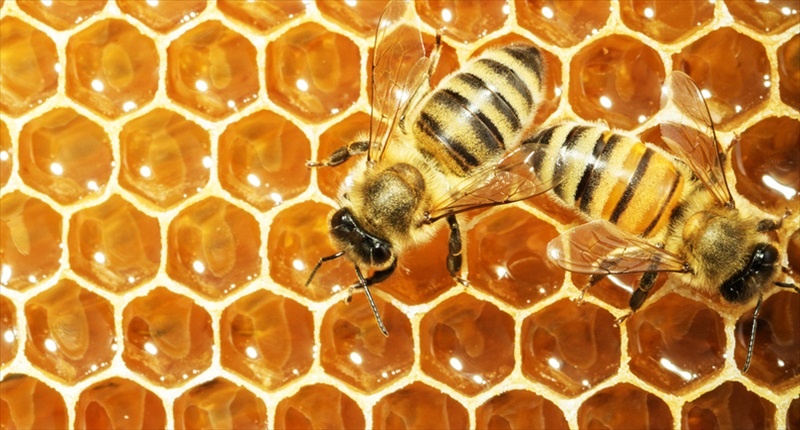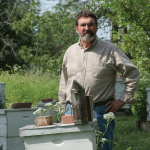By: Phil Craft
Got A Question? He Knows!
http://www.philcrafthivecraft.com
phil@philcrafthivecraft.com
Q: A beekeeper in Missouri writes:
This is my third year as a beekeeper, and I have been trying to be treatment free. However, every year I lose my bees over the Winter. I have now determined that my only hive has high numbers of mites (Varroa), and I really do not wish to lose this hive. I am prepared to treat, and soon. I read that oxalic acid is an organic treatment for mites. And I have purchased some, and am prepared to treat my hives next week. Will this solve my Varroa problem? (Bee Culture readers: I received this question in mid-August.)
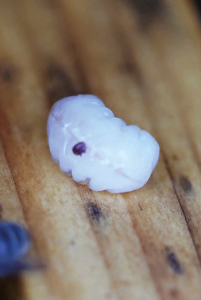 A: As a biologist I make a living from beekeeping and have for 20 years now, but my connection with bees is deeper than that and my interest in them more than financial or scientific. For me, beekeeping is both a family tradition and a cultural one, rooted in my ties to Eastern Kentucky. It’s also a satisfying, contemplative experience. In the early days of Spring, I watch the thermometer and can’t wait to get up to the apiary just to “crack the lids” and see how my little charges have made it through the Winter. When true Spring arrives, I love to spend mild, sunny mornings in the beeyard with a book and a pipe, even when there’s really nothing I need to do in the hives. I know the appeal of the slow-paced in an up-to-the-minute world, of real sights, sounds and smells when virtual reality presses around us, of maintaining some contact with nature in our daily lives. I understand why many small scale and backyard beekeepers are seduced by the idea of natural beekeeping without chemical treatments. But.
A: As a biologist I make a living from beekeeping and have for 20 years now, but my connection with bees is deeper than that and my interest in them more than financial or scientific. For me, beekeeping is both a family tradition and a cultural one, rooted in my ties to Eastern Kentucky. It’s also a satisfying, contemplative experience. In the early days of Spring, I watch the thermometer and can’t wait to get up to the apiary just to “crack the lids” and see how my little charges have made it through the Winter. When true Spring arrives, I love to spend mild, sunny mornings in the beeyard with a book and a pipe, even when there’s really nothing I need to do in the hives. I know the appeal of the slow-paced in an up-to-the-minute world, of real sights, sounds and smells when virtual reality presses around us, of maintaining some contact with nature in our daily lives. I understand why many small scale and backyard beekeepers are seduced by the idea of natural beekeeping without chemical treatments. But.
Varroa destructor is a devastating parasite which has been preying on bees in the United States for almost 30 years and is still the major cause of colony loss in this country. These mites suck the blood of both adult bees and pupae and are vectors for a host of devastating viruses. There is nothing natural about our having, however inadvertently, brought together this Asian predator with European honey bees on a continent where neither is native. In this unnatural situation, which we have created, the only natural consequence is for the honey bees to die. They have been doing so in great numbers. And still, 60% of small scale beekeepers do not monitor or treat for Varroa. I’m sorry if my bluntness offends, but responsible people would not be so neglectful of any other animal entrusted to their care – neither pets nor livestock.
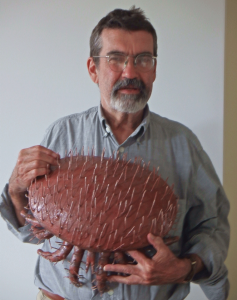 The first chemical treatments for Varroa were indeed harsh. They were commercial pesticides hurriedly adapted for use in hives to staunch the devastating losses following the introduction of mites. They had adverse effects on bees (though not so adverse as the parasite itself), and within a few years mites developed resistance to them. Since those early years, much research has been conducted to discover methods – chemical and nonchemical – of controlling mites without harming bees or leaving residues in wax and honey. It’s a problem, as one researcher put it, of trying to kill a bug on a bug without damaging the host. They are still working on it. However, we now have a lot more options when it comes to treating, each with its own advantages and limitations.
The first chemical treatments for Varroa were indeed harsh. They were commercial pesticides hurriedly adapted for use in hives to staunch the devastating losses following the introduction of mites. They had adverse effects on bees (though not so adverse as the parasite itself), and within a few years mites developed resistance to them. Since those early years, much research has been conducted to discover methods – chemical and nonchemical – of controlling mites without harming bees or leaving residues in wax and honey. It’s a problem, as one researcher put it, of trying to kill a bug on a bug without damaging the host. They are still working on it. However, we now have a lot more options when it comes to treating, each with its own advantages and limitations.
Which brings me to oxalic acid. It is definitely a weapon in our arsenal against mites; I recently bought an oxalic acid vaporizer for my own use. But it can’t fight the whole war by itself. It is designed to be used, as the label states, at times when brood is not present in the hive. One of the reasons that Varroa is such a difficult parasite to control is that it is present both on adult bees and on brood inside the cells. Most honey bee pests and diseases affect one or the other, but not both. Oxalic acid is what is sometimes referred to as a flash treatment. It kills mites quickly, but ONLY those on the adult bees. Mites in the cells are left alive. During Summer in your part of the country, and year around in areas where winters are mild, as much as 80% of the Varroa mites in a colony are inside the brood. That means that using oxalic acid at this time of year will only treat 20% of the problem. As mites in the brood emerge and reproduce, their numbers will rebound quickly.
With one exception, all Varroa control products registered for use in the U.S. have the same limitation: they do not kill Varroa in the brood cells where most of them are most of the time. The exception is the formic acid formulation sold by NOD Apiary Products as Mite Away Quick Strips. Several other products address this problem with multiple applications during a treatment period in order to kill successive generations of mites as they exit the cells. Others, such as Apivar, rely on a slow release of the active ingredient over a period of several weeks to achieve the same end. I do hear beekeepers talk about performing successive (typically three) back to back treatments with oxalic acid to catch newly emerging generations of mites. However, it is not without detrimental effects on adult bees. One application seems to cause negligible harm, but experts agree that using three close together invites serious bee loss in hives. That is the reason the label directions call for a single treatment while hives are broodless.
Many years ago a scientist performing research on oxalic acid told me that he would recommend it as an effective “clean up” treatment for use in late Fall, early spring, or even Winter. That is how I intend to use it in my own apiary. My usual practice, when indicated by monitoring (and it’s almost always indicated), is to treat in the Summer after taking honey supers off. This year, I intend to follow that up with Varroa checks in the late Fall: late October or November. If the numbers concern me, I will plan to use oxalic acid sometime in November or December – whenever I find little or no brood on the frames. Kentucky is far enough south that, depending on temperatures, we sometimes have brood present throughout the Winter. If that should turn out to be the case this year, I would need to make an alternative plan.
Can oxalic acid be useful in treating Varroa? Yes. Will it solve your varroa problem? No. I advise you to choose another treatment for immediate use in your hive. There are a number of effective products on the market. You can consult with your local apiary inspector or university extension specialist, but the decision is yours and it will require some research on your part. Keep in mind that some products are designed to be used in specific temperature ranges and may not be the best choice in hot weather. (I’ve visited Missouri in the Summer, and it can get HOT.) Some, as I mentioned before, require multiple applications. Is this workable for you? With most varroa treatments, honey supers must not be in place. With only one hive and at this time of year, that restriction shouldn’t be a problem for you, but you should be aware of it. Lastly, learn about possible side effects. Some may be aggravated by temperature, so educate yourself. Whatever method you choose, I congratulate you on deciding to treat. The worst side effect of all is when you allow Varroa to proliferate uncontrolled and all your bees die.
Q: A beekeeper in West Virginia writes:
I witnessed something today that I thought was crazy!!!
I found out this morning that my queen has a daughter. I just by chance saw her come out of her queen cell when I went into my hive today. There were several additional queen cells, they all appeared to be underdeveloped, so I took those out. However, I clearly saw a new queen emerge and be welcomed into the hive.
Then about two hours later, I saw 200 drones go into the box, at least, no exaggeration.
Did my Princess lose her virginity? What happened? Did I do well by killing the rest of the queen cells?
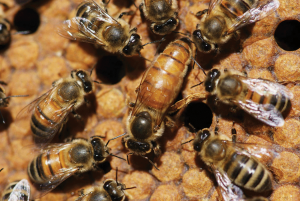 A: The role of the birds and the bees in plant propagation has long been used as a cute analogy for the mechanism of human reproduction. Perhaps because of that, most people are familiar with the way honey bees pollinate flowers as they move from bloom to bloom in search of nectar. Few, on the other hand, know much about the process which produces young bees. The opportunity to watch these fascinating creatures up close and learn about their behaviors is one of the main reasons we are beekeepers – that and the honey – and the queen’s reproductive biology is as amazing as it gets. It starts with fertilized eggs or young female larvae. Their destiny is to become worker bees, but sometimes the needs of the colony require that one or more be selected by her sisters to be reared as a queen. The story of how the newly emerged virgin queen, or princess as you call her, completes the next step of her passage is intriguing.
A: The role of the birds and the bees in plant propagation has long been used as a cute analogy for the mechanism of human reproduction. Perhaps because of that, most people are familiar with the way honey bees pollinate flowers as they move from bloom to bloom in search of nectar. Few, on the other hand, know much about the process which produces young bees. The opportunity to watch these fascinating creatures up close and learn about their behaviors is one of the main reasons we are beekeepers – that and the honey – and the queen’s reproductive biology is as amazing as it gets. It starts with fertilized eggs or young female larvae. Their destiny is to become worker bees, but sometimes the needs of the colony require that one or more be selected by her sisters to be reared as a queen. The story of how the newly emerged virgin queen, or princess as you call her, completes the next step of her passage is intriguing.
The mating process takes place at some distance from the hive in specific locations referred to as drone congregation areas (DCA’s). The name comes from the fact that sexually mature drones of a certain age (about 12 days and up) collect in these special spots. Though queens seek out the same sites, drones get naming rights, probably because the young queens are greatly outnumbered by their suitors. One of the most interesting aspects of DCA’s is that the same sites are used year after year. Since queens only mate during a short period early in their lives, and drones do not usually survive through the Winter, individual memory is not what guides them back from one season to the next. Pheromones dissipate too quickly to act as likely beacons. There must be some special physical characteristics of DCA’s which attract both drones and queens to a site where they have never been before, though generations of bees before them have used it for the same purpose. What those characteristics are is still one of the unsolved mysteries of honey bee biology.
More readily explained is the question of why the instinct to mate in relatively distant drone congregation areas evolved in the first place. In examining the origin of such hard-wired behaviors, the key is to determine what advantages they confer upon the colony. After all, mating flights are fraught with danger to the queen, as many beekeepers know who discover a colony queenless after a swarm. Why not mate within the safety of the hive, or at least closer to home? There must be some overriding advantage to DCA’s to compensate for the risks. There is, and it’s all about genetic diversity.
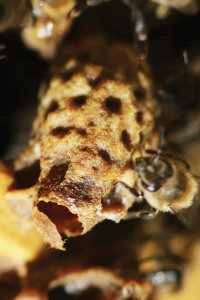 Virgin queens mating with drones from their own colony would mean sisters mating with brothers. Such inbreeding results in colossal genetic abnormalities which result in nurse bees removing affected larvae before emergence, increasing both brood mortality and the energy cost of producing young bees. Another negative effect of a small gene pool in a colony is reduced adaptability in the face of disease, parasites, or other stressors. In a genetically diverse community, some individuals may possess traits (such as natural resistance, hygienic behavior, or ability to better draw out wax and build up more quickly) which enable them to survive a threat and keep the colony going. In a more homogenous group, such traits are less likely to be present and the entire colony would face a more difficult path to survival.
Virgin queens mating with drones from their own colony would mean sisters mating with brothers. Such inbreeding results in colossal genetic abnormalities which result in nurse bees removing affected larvae before emergence, increasing both brood mortality and the energy cost of producing young bees. Another negative effect of a small gene pool in a colony is reduced adaptability in the face of disease, parasites, or other stressors. In a genetically diverse community, some individuals may possess traits (such as natural resistance, hygienic behavior, or ability to better draw out wax and build up more quickly) which enable them to survive a threat and keep the colony going. In a more homogenous group, such traits are less likely to be present and the entire colony would face a more difficult path to survival.
That is the problem. Drone congregation areas are the answer that evolution has devised. Drones and queens fly some distance to find DCA’s. It is thought that queens travel two to three kilometers, and there is some evidence that drones usually stay a bit closer to home. The difference in flying distances alone would reduce the chances of inbreeding. However, the fact that drones are programed to travel in search of a mate means that the cloud of eager bachelors at a given DCA includes drones from multiple colonies. Drones develop from unfertilized eggs – not an unusual way to produce males in the insect world – so they have only a single set of chromosomes. That means that all drones produced by one queen are genetically identical. Hence the importance of a source of unrelated drones. When the queen mates at a DCA, which scientists tell us she will do with between seven and 17 drones, there is an excellent chance that she will collect the semen of drones from several different colonies with different genetic characteristics. Later, when she fertilizes and lays her eggs and her daughters develop, they will be only half sisters, and the colony will be stronger for her early promiscuity.
That said, the drones you saw entering your hive may well have been returning from a visit to the local DCA. Once a drone starts hanging out there, he will make several trips each day. But did they make your princess a true queen? Not that day, and not those drones. Newly emerged queens, like drones, need a few days to mature before commencing their mating flights. Your young queen would not have fulfilled her destiny until about five or six days after you saw her emerge from her queen cell. Even then, she probably would not have mated with drones from her own colony and the drones she mated with would not be returning home. (Drones die after mating.) It is also possible that the bees you saw were a group of young drones coming back from an orientation flight. All honey bees make short initial test flights – workers before beginning to forage and queens and drones before mating flights – both to practice flying and to imprint upon their surroundings so that they will be able to find their way home again. Hence the name orientation flights. They typically occur en masse on warm, sunny afternoons with little wind. Since those are exactly the conditions most likely to entice me out into the apiary, I have watched many such flights take place. Suddenly there will be a great flurry of activity at the hive entrance, with bees flying out and returning. A short time later, all is calm. Unlike the commotion associated with swarm activity, there is no cloud of bees swirling and buzzing above my apiary, and no cluster settling onto a branch.
You did not mention whether or not you saw an old queen in the hive in which the new one emerged. If she was not there, your colony probably swarmed several days ago. If both were present together, you saw a supersedure taking place. In either case, the bees would have destroyed the additional queen cells if you had not done so, or the new queen herself would have. Personally, I rarely destroy queen cells, preferring to stay out of the business of queen production in my hives. My theory is that if the colony reaches a consensus to swarm and gets to the point of building queen cells, it’s too late for me to stop them, and if they decide to supersede, they probably know something that I don’t know. The greatest risk in destroying queen cells is that the colony has swarmed and you have just killed the successor. Since you actually saw the new queen emerging, (How cool is that?) it isn’t a concern in your case. You didn’t do any harm by eliminating those cells, though it was probably unnecessary.




